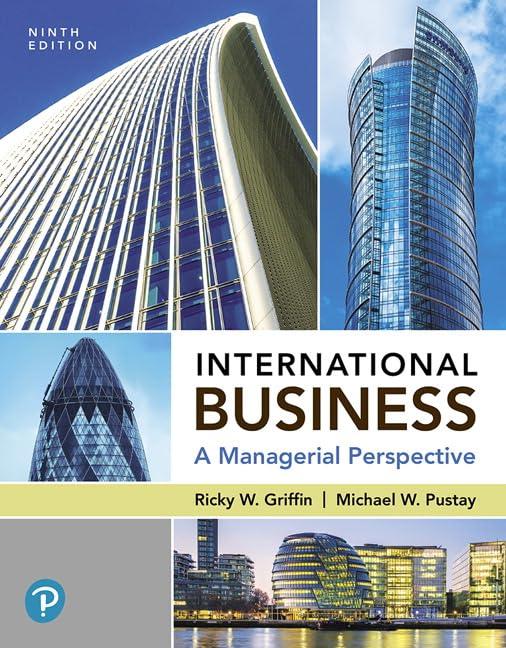Why is China trying to keep the value of its currency from rising? What would be the
Question:
Why is China trying to keep the value of its currency from rising? What would be the impact on the Chinese economy, Chinese workers, and Chinese consumers if the yuan were to rise in value?
China’s successful industrialization and remarkable economic development in the decades following Mao-Tse Tung’s death in 1976 provides a wonderful example of the theory of competitive advantage and the Heckscher-Ohlin theorem. The economic policies championed by Deng Xiaoping and his successors have unleashed the entrepreneurial talents of Chinese businesspeople and unshackled millions of Chinese peasants from the chains of rural poverty. This economic miracle was in large part due to the low wages that were paid to Chinese workers and the adoption of foreign technology, often transferred through foreign direct investment. The low wages in turn resulted from the migration of millions of rural Chinese, eager to escape the back-breaking labor and low incomes earned in farming, to urban areas. With so many people living in rural areas, a typical plot of land was too small to benefit from mechanized labor; every stage of the crop cycle, from planting to weeding to fertilizing to harvest, was done by hand.
When Deng liberalized China’s economic policies, residents of rural inland China, particularly teenagers and young adults despairing of being condemned to eke out a living from the land like their parents and grandparents, migrated first to the new economic zones in Shenzhen and Xiamen and later to coastal cities such as Tianjin and Qingdao to seek work in the new factories sprouting up. Each year, thousands of new factories were built, and each year millions of rural Chinese journeyed to them in hopes of a new life. All told, the journeys of rural Chinese to the cities of coastal China represented the largest internal migration in the history of the world—some 250 million people. Because the flow of new labor matched the needs of the new factories, the price of labor stayed low.
As the theory of comparative advantage suggests, China had a comparative advantage in the production of goods requiring low-cost, unskilled labor. Indeed, a common buzzword used by CEOs and business gurus a decade ago was the “China price”—a phrase suggesting that if a potential supplier wanted to sell components, they had to match or beat what it would cost to fabricate in China. Many companies in Europe and North America discovered they could not match the China price from their domestic factories. As a result, they outsourced production to a Chinese supplier, built their own factory in China, or simply lost the business to a Chinese rival.
One of the reasons economics is often called the dismal science is because economic success often breeds economic failure. In China’s case, the factors that led it to becoming so successful in the 1990s and 2000s are now creating problems for the country’s continued economic growth.
China’s working age population, which was growing rapidly in the previous two decades, has now begun to shrink, as a result of the country’s one-child policy. Demographers estimate in 2005, 131 million Chinese were in the 15 to 19 age cohort; by 2010, that cohort had shrunk to 107 million; by 2017, it fell to 75 million. The rapidly growing coastal cities suffer from congestion, raising the costs of doing business. And, as surplus rural labor has migrated to the cities, the wages of those remaining in the rural areas has increased. Moreover, to continue to attract rural migrants, employers in coastal China have been forced to raise wage rates. Turnover is a problem because workers will quit jobs and move to a new factory for small raises, more opportunities for overtime, or even better food in the factory canteen. In 2016, China’s average wage rose 9.8 percent, the slowest year-to-year growth in the decade. This is on top of annual increases in labor costs of 12 percent to 14 percent a year during the decade of the 2000s.
Euromonitor estimates that average labor cost in China is \($3.60\) an hour (up from \($0.60\) in 2000). In tier one cities like Beijing and Shanghai, average monthly salaries are higher than in some EU countries, such as Latvia and Lithuania. Boston Consulting Group argues that Chinese labor costs are now above those of Mexico, after adjusting for differences in labor productivity. Moreover, Mexico benefits from its geographic relationship to the large North American market. Not only are transportation costs less, but firms selling fashion-sensitive or customdesigned goods benefit from shorter supply lines. Foxconn, for example, assembles standardized laptops in China, but customized ones—some 35,000 a day—in its facility in Ciudad Juárez, across the border from El Paso.
Wage increases are not the only concern. As industrial complexes in coastal areas have sprouted, congestion costs, land prices, environmental and safety regulations, and taxes have climbed as well. Of even greater concern is the rising value of the yuan. U.S. and European politicians believe that China is suppressing the value of its currency to protect its factories from these cost pressures. Should the yuan rise in value, the pricing advantages that Chinese exporters once enjoyed will erode further vis-à-vis Mexico or Asian rivals with low labor costs, such as Vietnam and Bangladesh. Because of the wide disparities in income levels between rural and urban China, Communist Party officials fear that a drying up of China’s exports could lead to social unrest and possible challenges to their right to govern.
Step by Step Answer:






